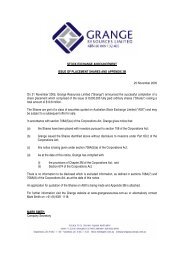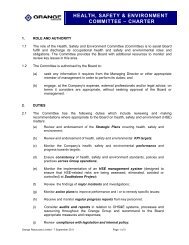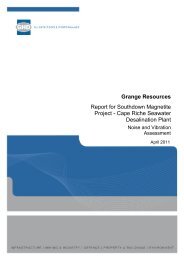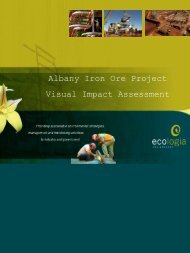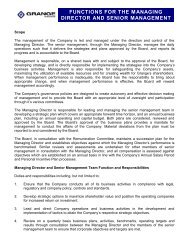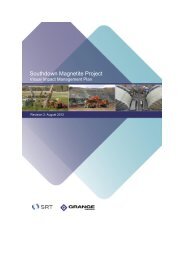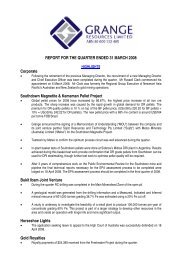2012 Annual Report (2 April 2013) - Grange Resources
2012 Annual Report (2 April 2013) - Grange Resources
2012 Annual Report (2 April 2013) - Grange Resources
You also want an ePaper? Increase the reach of your titles
YUMPU automatically turns print PDFs into web optimized ePapers that Google loves.
60<br />
PAGE<br />
<strong>2012</strong> ANNUAL REPORT<br />
Notes to the Financial Statements (cont.)<br />
NOTE 1. SUMMARY OF SIGNIFICANT<br />
ACCOUNTING POLICIES (cont.)<br />
(ai) New accounting standards<br />
and interpretations (cont.)<br />
(vi) AASB Interpretation 20 Stripping Costs in the<br />
Production Phase of a Surface Mine and AASB 2011-<br />
12 Amendments to Australian Accounting Standards<br />
arising from Interpretation 20 (effective 1 January <strong>2013</strong>)<br />
Interpretation 20 sets out the accounting for overburden<br />
waste removal (stripping) costs in the production phase of a<br />
mine. It states that these costs can only be recognised as an<br />
asset if they can be attributed to an identifiable component<br />
of the ore body, the costs relating to the improved access to<br />
that component can be measured reliably and it is probable<br />
that future economic benefits associated with the stripping<br />
activity (improved access to the orebody) will flow to the<br />
entity. The costs will be amortised over the life of the identified<br />
component of the ore body.<br />
This is different to the Group’s current accounting policy which<br />
is to capitalise stripping costs based on a life of mine wasteto-ore<br />
stripping ratio and amortise the costs over the life of<br />
the mine. The interpretation must be applied prospectively<br />
from earliest period presented and the Group will have to<br />
write off existing stripping asset balances of $130.2 million as<br />
at 1 January <strong>2012</strong> to retained earnings, unless they relate to<br />
an identifiable component of the ore body.<br />
The Group continues to review its existing stripping cost<br />
assets in light of the requirements of the interpretation<br />
and is unable to quantify the effect, if any, on the<br />
amounts recognised in the financial statements as at<br />
31 December <strong>2012</strong>.<br />
(vii) AASB <strong>2012</strong>-5 Amendments to Australian Accounting<br />
Standard arising from <strong>Annual</strong> Improvements 2009-2011<br />
cycle (effective 1 January <strong>2013</strong>).<br />
In June <strong>2012</strong>, the AASB approved a number of amendments<br />
to Australian Accounting Standards as a result of the 2009-<br />
2011 annual improvements project. The Group will apply<br />
the amendments from 1 January <strong>2013</strong>. The Group does not<br />
expect that any adjustments will be necessary as a result of<br />
applying the revised rules.<br />
NOTE 2. FINANCIAL RISK MANAGEMENT<br />
The Group’s activities expose it to a variety of financial risks:<br />
market risk (including currency risk, interest rate risk and price<br />
risk), credit risk and liquidity risk. The Group’s overall risk<br />
management program focuses on the unpredictability of financial<br />
markets and seeks to minimise potential adverse effects on the<br />
financial performance of the Group. The Group has previously<br />
used derivative financial instruments such as foreign exchange<br />
contracts to manage certain risk exposures. Derivatives are<br />
exclusively used for hedging purposes, i.e. not as trading or other<br />
speculative instruments. The Group uses different methods to<br />
measure different types of risks to which it is exposed. These<br />
methods include sensitivity analysis in the case of interest rate,<br />
foreign exchange and commodity price risks and aging analysis<br />
for credit risk.<br />
Risk management is carried out by a Treasury Committee under<br />
a policy approved by the Board of Directors. The Treasury<br />
Committee identifies, evaluates and manages financial risks<br />
according to parameters outlined in an approved Treasury<br />
policy. The Treasury policy provides written principles for overall<br />
risk management, as well as policies covering specific areas,<br />
such as foreign exchange risk, interest rate risk, credit risk, use<br />
of derivative financial instruments and non-derivative financial<br />
instruments, and investment of excess liquidity.<br />
The Group holds the following financial instruments:<br />
<strong>2012</strong> 2011<br />
$’000 $’000<br />
Financial Assets<br />
Cash and cash equivalents 119,918 172,269<br />
Term deposits 55,000 16,738<br />
Trade and other receivables 25,703 51,326<br />
200,621 240,333<br />
Financial Liabilities<br />
Trade and other payables 34,982 49,424<br />
Borrowings 22,929 44,887<br />
Deferred consideration 49,586 65,351<br />
107,497 159,662



